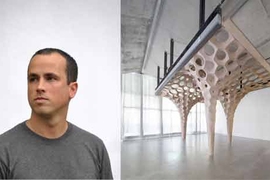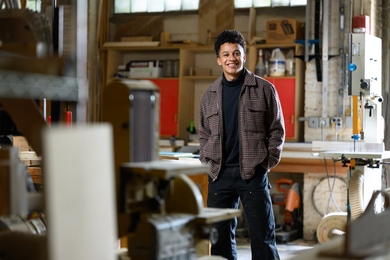Brandon Clifford has gone to Rome to look for ghosts. An assistant professor in the Department of Architecture, Clifford is in the Eternal City on a yearlong residency at the American Academy, one of approximately 30 American scholars to be awarded the Founders Rome Prize fellowship for 2017-18. His project, “Ghosts of Rome,” continues his innovative research into how ancient knowledge can engage with current technologies.
“An obelisk that was transported from Egypt to Rome — how was it made? What did it feel like to watch the procession when it arrived?” asks Clifford, who is also co-founder of the firm Matter Design. “We tend to think of architectural elements as static. But the truth is that we are constantly interacting with them. And this is lost knowledge that could inform contemporary architecture.”
For a 2012 project that encompassed history and technology, Clifford used computer code and advanced fabrication techniques to create a compression-only, medieval-style birch plywood vault named “La Voute de LeFevre.” A year later, he nested precast, unreinforced concrete treads to fashion “Helix,” a half-scale spiral staircase. “I’ve traveled the world,” he says, “to find objects and techniques that I could then recreate with digital technologies and contemporary materials.”
The son of an astronaut, Clifford studied architecture as an undergraduate at Georgia Tech and earned a master’s degree in architecture from Princeton University. In 2008, along with Georgia Tech classmate Wes McGee, he founded Matter Design. The studio and research initiative bridges the Stone Age and the digital age, transposing ancient techniques such as custom masonry onto materials and language that resonate with 21st-century sensibilities and scales.
“Brandon’s research into lost or forgotten building technologies not only reintroduces these technologies into current-day discourse,” says Meejin Yoon, head of the Department of Architecture at MIT. “It also advances our understanding of the past and of the possibilities of our present.”
This innovative work garnered multiple prizes and awards in the years after Clifford and McGee launched their studio. Still, the effort was centered primarily on questions of materials and methods. That began to change in 2014, when Clifford built “Round Room” in the School of Architecture and Planning’s Keller Gallery. The “Round Room” was a baroque interior realized with unique aerated concrete elements carved by a robotic arm and assembled according to an ancient Incan wedge technique. While primarily a structural and acoustical experiment, that project also afforded visitors an opportunity to enter and experience the space, each imbuing it with his or her individual reality.
A breakthrough in Clifford’s thinking occurred in spring 2015, when he co-taught 4.154 (Architecture Design Option Studio — Megalithic Robotics) with Mark Jarzombek, professor of architectural history and theory. In that course, professors and students traveled to Peru to study Incan megaliths, then returned to campus to design and build their own.
Midway through the class, teaching assistant Carrie McKnelly lost both of her parents. The students, who had learned that the Inca often erected megaliths in honor of their departed, elected to dedicate their own megalith to McKnelly’s parents. “It opened their eyes to how architecture can shape the social fabric of their world,” says Clifford.
For Clifford, layered onto the story of loss and remembrance — and the electrifying experience of watching his students hoist their 2,000-pound megalith on MIT’s Killian Court using only human power and a few ropes — was the importance of myth.
“The first Dutch explorers who landed at Easter Island were told that these enormous stone sculptures had walked themselves from the quarry to where they are now. You can dismiss the story as folklore, but it tells us volumes about how easily these stones were actually transported,” says Clifford. “It doesn’t matter whether these stories are true or not. It’s like the telling of a good ghost story, when the listener experiences the thrill of moving through that fiction. They affect our perception of architecture. And that is a space I like to explore.”
Clifford entered that space with a 2016 project called “Buoy Stone.” Drawing on a myth that the smaller stones at Stonehenge were floated up the River Avon using animal bladders, he crafted a fiberglass “stone” designed to rest on its side as it was moved through the waters of the Charles River, and then to stand upright once filled with river water.
The project was conceived to commemorate the 100th anniversary of MIT’s move across the river from Boston to Cambridge. “So many people have told me that they’ve seen that object while they run along the Charles,” says Clifford. “Perhaps they’ll tell someone they’ve seen a floating stone, and I’ll have created my own fiction and myth.”
In Rome, Clifford is accompanying archeologists and historians, visiting monuments and archaeological sites, and peeling back the many layers of civilization that have left their mark on the Italian capital. But as much as he is fascinated by history, he stresses that he’s not overly interested in reliving it.
“I’m not concerned with trying to prove or disprove the past,” he says. “I want to go ghost hunting, to use these stories and histories and myths to shape a new architectural future.”












